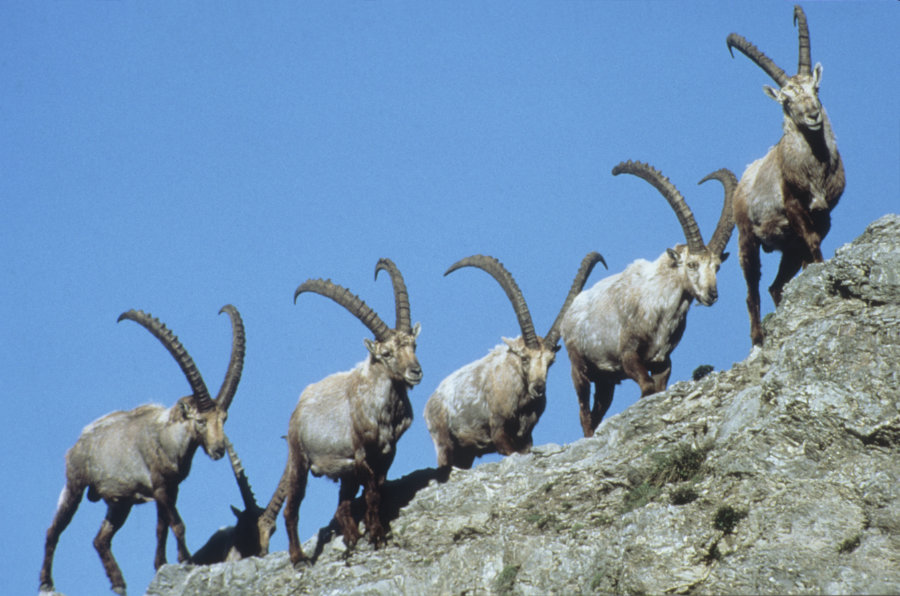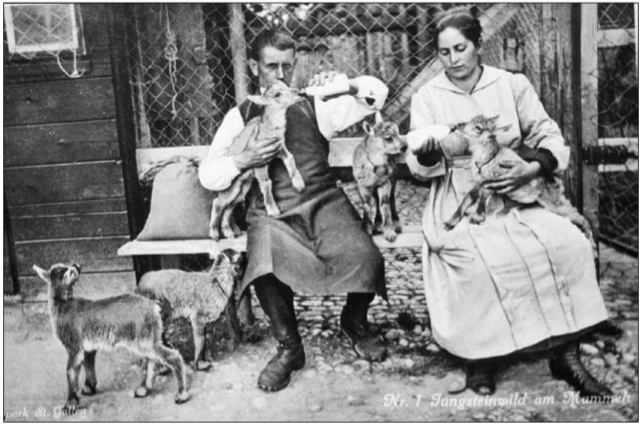Song of praise to a poacher!
A Crime Thriller of Game Biology
by Heini Hofmann
That the end justifies the means is not an honourable doctrine. Nonetheless, it happens that an evil deed at the time of the event mutates into a good deed in the rear view mirror of history. A prime example is the reintroduction of the Alpine ibex more than a century ago. Today we praise as ingenious what was once considered illegal.

The tragicomical ballad of extinction and resurrection of the Alpine ibex sounds like a fairy tale from the Arabian Nights. The survival of this proud mountain goat once hung on a thin thread. Today, the rescue and pan-alpine reintroduction of stone animals is considered the world’s largest and most successful wildlife biology experiment.
Twisted world
Irony of fate: The “King of the Mountains” owes its last-minute survival to a veritable hunting king in Bella Italia, a Swiss Federal Councillor who failed in his negotiating tactics, two conspiratorial friends in St. Gallen who became active as a result, and, above all to a poacher who was a master of his profession like no other …
At first, that does not sound like a good story, unless you read it with the eyes of La Rochefoucauld, who said: “Some people are disgusting despite their merits, and some are pleasant despite their mistakes. Such a twisted view may make it easier for the inclined reader to follow the intricate logic.
But let us start at the beginning, and that is not a good one. The reason why the stone game was practically completely extinct in the early 19th century is a very simple and shameful, namely ruthless hunting and poaching, which was not primarily about meat and trophies, but about a misguided zeitgeist.
Climbing pharmacy
What actually sealed the fate of the ibex was superstitious folk medicine. The concentrated power of the mighty horn bearer, its elegant art of climbing, despite its seemingly clumsy body, and the extreme toughness against the murderous strains of the mountain winter made the ibex a symbol of robust health in the eyes of the people.
Almost everything from this “climbing pharmacy” should be good for or against something, healing or magical, from horn to heart, marrow and blood to bezoar stones (licked hair glued together to a sphere in the stomach) and heart crosses (ossifications in the exit area of the heart arteries). Therefore, killing an ibex was a worthwhile undertaking. Even the bishops of Salzburg operated veritable “ibex pharmacies”.
Forbidden by corporal punishment
Macabre are the stages of the dethronement of the “King of the Alps”, demonstrated here by using Switzerland as an example. As early as 1550, the last ibex was killed in Glarus, 1583 in the Gotthard region and 1770 in the Bernese Oberland. In 1612, a decree was issued in Grisons for the protection of rock game which, since ineffective, in 1633 was followed by a more stringent decree, “that no one should dare any form of catching or shooting stone goats, otherwise he will be treated with corporal punishment”.
But even the threat of the death penalty was of no use. By 1640 the stone game was also a legend in Grisons. In central Switzerland it was exterminated in 1661. Only in the Valais it was able to survive longer, but only until 1809. After that, Switzerland was poorer by a proud game species. Actually shameful, in 1875, when there were no ibexes left, they were placed under protection at federal level ...
Royal Rescue
In the non-Helvetian Alpine region, the stone deer had not fared better. Only in the Piedmontese mountains, at the Gran Paradiso (nomen est omen!) the last colonies were able to hold their ground, however, they withered despite a protection law. The rescue did not come until the Italian crown acquired exclusive hunting rights in the entire rock game area of the Valle d’Aosta.
King Vittorio Emmanuele II, himself a passionate hunter (therefore called Re cacciatore), appointed a large number of gamekeepers, banned all hunting – except royal hunting – and severely punished poaching. Success was not long in coming. In this last refuge the ibexes increased appreciably. Royal rescue for the “king of the mountains”! The successive kings, Umberto I and Vittorio Emmanuele III, also continued the care of the stone game. Their hunting ground later became the Parco Nazionale Gran Paradiso.
Smuggled – and how!
Gradually, the desire for the reintroduction of the Alpine king was expressed also in Switzerland. The Confederation supported this idea in a law, but did not do anything concrete. Hence, it was private interest groups that took the initiative. First attempts with bastards from cross-breeding domestic goats with mountain goats failed.
After the occasion of the Simplon celebration of 1905, Federal Councillor Joseph Zemp had tried in vain to get King Vittorio Emmanuele III to deliver some ibexes, it came to the “stratagem”. In other words: A good work, namely the reintroduction of stone deer in the Alps, began with an “evil” act – but without that act the Alpine stone goats most probably would not exist anymore.
Sly poacher
The promoters of this crime, which later mutated into a good deed, were the St. Gallen Wildpark (wildlife park) initiators, Walhalla hotelier and “Steinbock father” (ibex father) Robert Mader and the physician Albert Girtanner, author of the first ibex monograph. Their accomplice was an Italian poacher.
In an adventurous smuggling operation in June 1906, three ibexes, two female kids and a male kid, arrived in Switzerland from Italy.
Professional poacher Giuseppe Bérard from the Valle d’Aosta had stolen them in the royal hunting ground – after having played a trick on the mother animals – whereby he made sure that they had already sucked their first mother’s milk (colostrum), which made them more resistant. Then he carried them from Gran Paradiso to Valais, carefully avoiding gamekeepers and policemen.
This happened by means of an ingenious base camp strategy, so that the young animals could survive. Along the way, the ibex kids, which were dependent on milk food, were repeatedly put on teats of a domestic goat – housed in a hideout in the rocks at certain intervals – so that they would stay fit for the next leg: a poacher´s logistic masterpiece! Arrived at the St. Gallen Game Park “Peter and Paul”, the ibex kids were raised with milk bottles. These three animals became the starting point for a historically unique resettlement campaign.
Long awaited first exposure
Soon more smuggled animals followed. When the first offspring appeared in 1909 in the St. Gallen zoo the joy was huge. The persistent efforts and daring actions of the two St. Gallen promoters brought success – the physician involved had even risked to give the poacher chloralosis a forbidden narcotic…
On 8 May 1911, the time had come: the first five stone animals being raised in the “Peter and Paul” wildlife park could be released in the ban area of the “Grauen Hörner” (Grey Peaks) in the St. Gallen Oberland, first in an open-air enclosure, where they jumped out in the same year. More than a hundred years after extinction, wild stone game was once again reality in the Swiss Alps!
This healing of wounds in nature met with great sympathy among the population and was classified as an event of national importance: a milestone in the pioneering age of nature protection. (The Swiss League for Nature Protection was only founded in 1909, and the Swiss National Park in the Lower Engadine was still in emergence.)
“Peter and Paul” and “Harder”
Now, of course, further reintroductions had to follow if one wanted to make the wild goat native again in the Alps; because ibex colonies hardly migrate but remain attached to their relatively small habitat.
In the meantime, the population in the wildlife park “Peter and Paul” had increased rapidly, so that in 1915, St. Gallen was able to cede animals to the newly founded alpine wildlife park “Interlaken-Harder” (where also animals smuggled from Italy arrived), so that from then on two breeding stations could take part in releases, first in Switzerland and as from the 1950s also in other Alpine countries.
After the successful first release in 1911 (Graue Hörner) and an unsuccessful attempt in 1914 in the Ela area above Bergün, further colonies were founded in the Swiss Alps until 1938, among them: 1920 National Park, 1921 Piz Albris and Augstmatthorn, 1924 Black Monk, 1926 Wetterhorn, 1928 Mont Pleureur and 1938 Aletsch area.
Shooting of the wild population is necessary
In the fifties, resettlements of game had already started (first by means of box traps, later by narcosis rifles) because parts of the colonies (having multiplied in the meantime) developed so well. Not only in the Swiss Alps, but also pan-alpine, several thousand animals have been released or transferred until today.
For years now, in various regions of Switzerland (and in other countries) – not least in the interest of the stone game itself – it has become necessary to shoot down game, as damage had been caused to protection forests and avalanche protection reforestations in some places. Today, hunting based on biological criteria according to the Grisons model is a showpiece of modern game management.
Unique in the world
Thus, the Alpine ibex, a symbol of nature conservation, has returned so successfully after a sad near extinction that it almost stumbled over its own success. Ergo: A pan alpine success story – worldwide unique, that, one is amazed, surpasses even that of the American bison, initiated in Switzerland – and based on poaching! •
(Translation Current Concerns)
